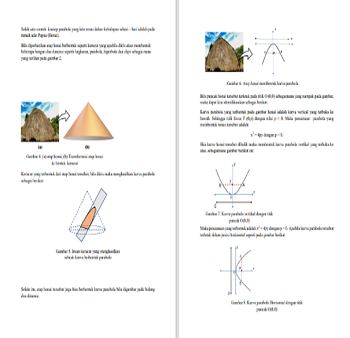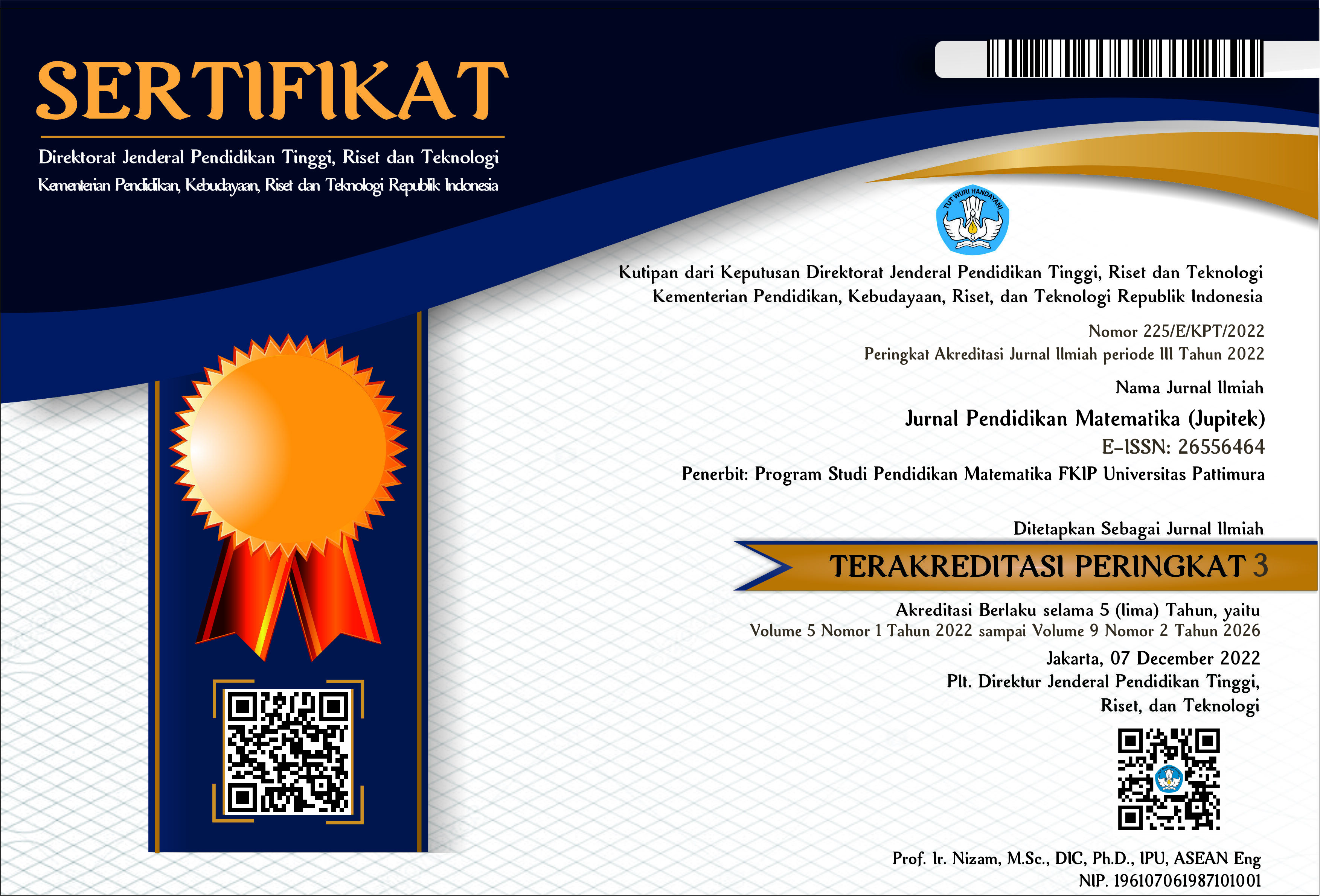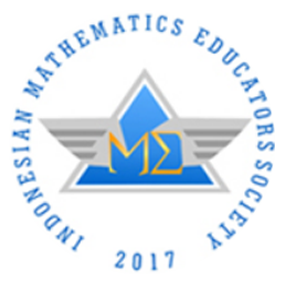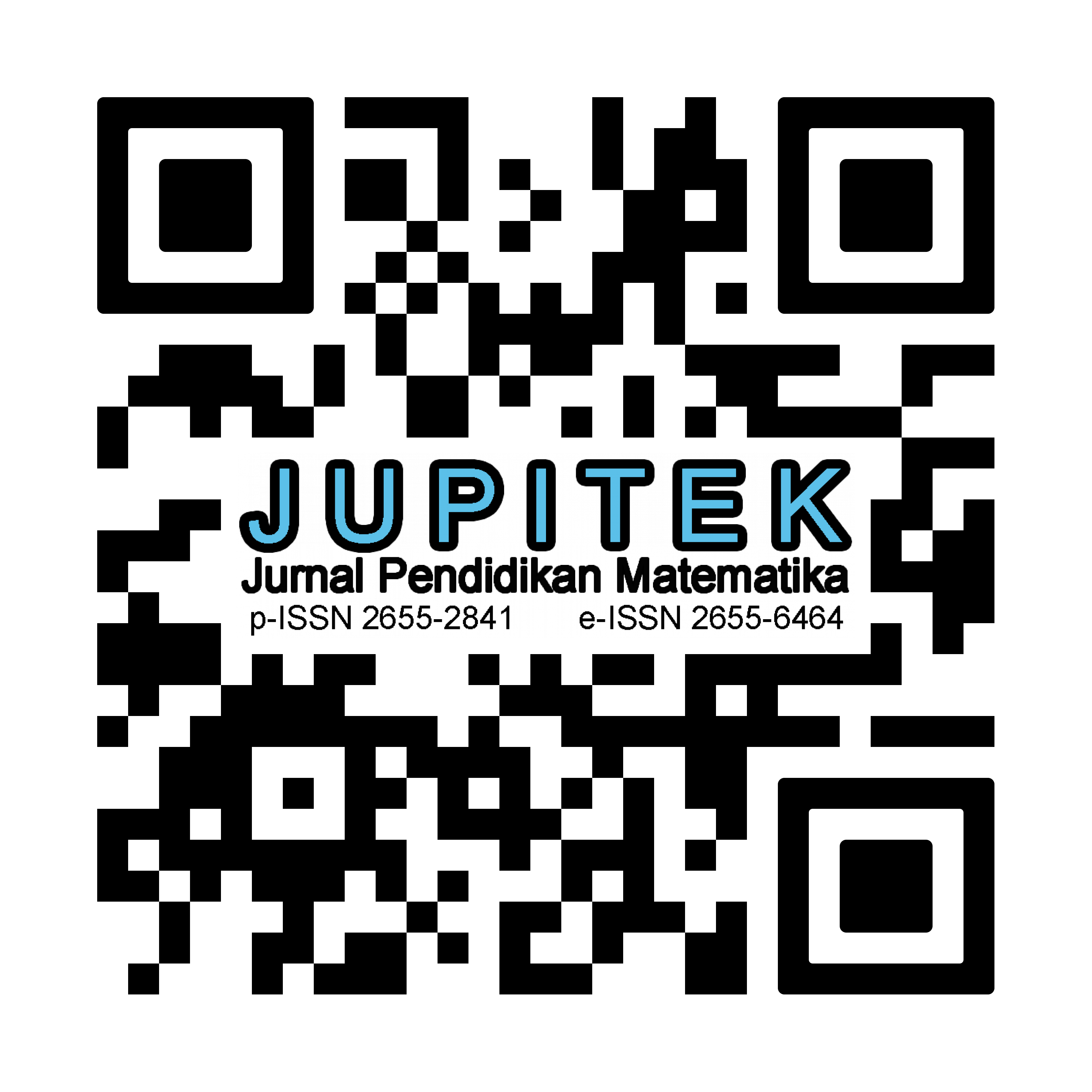ETHNOMATHEMATICS-BASED LEARNING DESIGN OF MOUNTAINOUS PAPUA TO INCREASE STUDENT ENGAGEMENT AND CREATE MEANINGFUL LEARNING
Abstract
The application of ethnomathematics in teaching has many benefits. Cultural diversity can be an interactive learning resource for students. One culture that has high ethnomathematics potential is the Papuan Mountain culture. Although several examples of ethnomathematics have been found in Papuan culture, the design of ethnomathematics applications in learning is still very minimal. In addition, the lack of student involvement in the ethnomathematics exploration process is an important reason for the need to develop ethnomathematics-based learning based on 21st-century learning. The type of research is research development by using the nine stages of Dick and Carey’s development. The results of research and development concluded that the mountain ethnomathematics-based learning design was developed in 4 main stages, namely analysis, development design, implementation, and evaluation. Strategies that can be used in ethnomathematics-based learning in Papua Mountains to increase learner involvement and create meaningful learning are exploration, oriented to problem statements, constructing knowledge and experiences of learners based on their culture. The results of the analysis show that the ethnomathematics-based learning design of the culture of the Papua Mountains is good and feasible to implement with a validity index of 0.802 while the reliability index of rater agreement on the learning design is good, namely 0.896.
Downloads
References
Andriono, R. (2021). Analisis Peran Etnomatematika dalam Pembelajaran Matematika. ANARGYA: Jurnal Ilmiah Pendidikan Matematika, 4(2). https://doi.org/10.24176/ANARGYA.V4I2.6370
Ergene, Ö., Ergene, B. Ç., & Yazıcı, E. Z. (2020). Ethnomathematics activities: Reflections from the design and implementation process. Turkish Journal of Computer and Mathematics Education, 11(2), 402–437. https://doi.org/10.16949/turkbilmat.688780
Fajriyah, E. (2018). Peran Etnomatematika terkait Konsep Matematika dalam Mendukung Literasi. PRISMA: Prosiding Seminar Nasional Matematika. https://journal.unnes.ac.id/sju/prisma/article/view/19589
Galloway, K. R., & Bretz, S. L. (2015). Development of an Assessment Tool to Measure Students’ Meaningful Learning in the Undergraduate Chemistry Laboratory. Journal of Chemical Education, 92(7), 1149–1158. https://doi.org/10.1021/ED500881Y/ASSET/IMAGES/MEDIUM/ED-2014-00881Y_0006.GIF
Hartanti, S., & Ramlah, R. (2021). Etnomatematika: Melestarikan Kesenian dengan Pembelajaraan Matematika. Ideas: Jurnal Pendidikan, Sosial, Dan Budaya, 7(2), 33. https://doi.org/10.32884/ideas.v7i2.347
Hasibuan, E. K. (2018). Analisis Kesulitan Belajar Matematika Siswa pada Pokok Bahasan Bangun Ruang Sisi Datar di SMP Negeri 12 Bandung. AXIOM : Jurnal Pendidikan Dan Matematika, 7(1). https://doi.org/10.30821/AXIOM.V7I1.1766
Heryan, U. (2018). Meningkatkan Kemampuan Komunikasi Matematis Siswa Sma Melalui Pendekatan Pembelajaran Matematika Realistik Berbasis Etnomatematika. Jurnal Pendidikan Matematika Raflesia, 3(2), 94–106. https://doi.org/10.33369/JPMR.V3I2.6290
Iftitah, S. L. (2023). Designing Effective Instructional Media in Early Childhood Education: A Comparative Review of the ADDIE and Dick and Carey Instructional Design Models. Advances in Educational Technology, 2(1), 49–70. https://creativecommons.org/licenses/by/4.0/
Irawan, A., & Kencanawaty, G. (2017). Implementasi Pembelajaran Matematika Realistik Berbasis Etnomatematika. Journal of Medives : Journal of Mathematics Education IKIP Veteran Semarang, 1(2), 74–81. https://www.e-journal.ivet.ac.id/index.php/matematika/article/view/483
Koo, T. K., & Li, M. Y. (2016). A guideline of selecting and reporting intraclass correlation coefficients for reliability research. Journal of Chiropractic Medicine, 15(2), 155. https://doi.org/10.1016/J.JCM.2016.02.012
Laurens, T., & Matitaputty, C. (2018). Pengembangan Perangkat Pembelajaran Materi Persegi Dan Persegi Panjang Menggunakan Strategi React. JUPITEK, 1(1), 51–57. https://doi.org/DOI: https://doi.org/10.30598/jupitekvol1iss1pp47-53
Lukman, A., Hairi, A. P., Rahmi, A., Fadli, A., Dongoran, S. B., & Nasution, A. A. (2020). Penerapan Media Pembelajaran Holo-Math (Hologram Mathematics) Dalam Meningkatkan Kemampuan Visual Matematis Siswa Di SMP Negeri 8 Percut Sei Tuan. Jurnal Fibonaci: Jurnal Pendidikan Matematika, 1(2), 15–27. https://doi.org/10.24114/JFI.V1I2.21902
Miranda, J., Navarrete, C., Noguez, J., Molina-Espinosa, J. M., Ramírez-Montoya, M. S., Navarro-Tuch, S. A., Bustamante-Bello, M. R., Rosas-Fernández, J. B., & Molina, A. (2021). The core components of education 4.0 in higher education: Three case studies in engineering education. Computers and Electrical Engineering, 93(September 2020). https://doi.org/10.1016/j.compeleceng.2021.107278
McHugh, M. L. (2012). Interrater reliability: The kappa statistic. Biochemia Medica, 22(3). https://doi.org/10.11613/bm.2012.031
Obizoba, C. (2015). Instructional Design Models-Framework for Innovative Teaching and Learning Methodologies. International Journal of Higher Education Management (IJHEM), 2.
Paul Telussa, R., & Tamaela, K. A. (2023). Science E-Module Based on Ethnoscience. International Journal of Elementary Education, 7(4), 657–665. https://doi.org/10.23887/ijee.v7i4.70120
Ridha, S., Putri, E., Kamil, P. A., Utaya, S., Bachri, S., & Handoyo, B. (2020). The importance of designing GIS learning material based on spatial thinking. IOP Conference Series: Earth and Environmental Science, 485(1), 012027. https://doi.org/10.1088/1755-1315/485/1/012027
Pornpimon, C., Wallapha, A., & Prayuth, C. (2014). Strategy Challenges the Local Wisdom Applications Sustainability in Schools. Procedia - Social and Behavioral Sciences, 112. https://doi.org/10.1016/j.sbspro.2014.01.1210
Saqr, M., López-Pernas, S., Helske, S., & Hrastinski, S. (2023). The longitudinal association between engagement and achievement varies by time, students’ profiles, and achievement state: A full program study. Computers & Education, 199, 104787. https://doi.org/10.1016/J.COMPEDU.2023.104787
Saranga, N., Kho, R., & Hadiyanti, Y. R. (2023). Eksplorasi Etnomatematika Pada Rumah Adat Masyarakat Skouw Sae. Jurnal Ilmiah Mandala Education, 9(2), 886–892. https://doi.org/10.58258/jime.v9i2.4727
Sroyer, A. M., Nainggolan, J., & Hutabarat, I. M. (2018). Exploration of Ethnomathematics of House and Traditional Music Tools Biak-Papua Cultural. Formatif: Jurnal Ilmiah Pendidikan MIPA, 8(3), 175–184. https://doi.org/10.30998/FORMATIF.V8I3.2751
Sugiyono. (2019). Metode Penelitian Pendidikan Pendekatan Kuantitatif, Kualitatif, dan R&D. Alfabeta.
Theola, C., Wardoyo, P., Veronica, L., Gomes, A., Rudhito, M. A., & Adat, R. (2024). Etnomatematika Pada Rumah Adat Honai Suku Dani Dan Implementasinya Dalam Rancangan Pembelajaran Matematika. 11(1).
Widana, I. W., Parwata, I. M. Y., Parmithi, N. N., Jayantika, I. G. A. T., Sukendra, K., & Sumandya, I. W. (2018). Higher Order Thinking Skills Assessment towards Critical Thinking on Mathematics Lesson. International Journal of Social Sciences and Humanities (IJSSH), 2(1), 24–32. https://doi.org/10.29332/ijssh.v2n1.74

Copyright (c) 2024 Yuliana Olga Siba Sabon, Rivaldo Paul Telussa

This work is licensed under a Creative Commons Attribution-NonCommercial-ShareAlike 4.0 International License.
License and Copyright Agreement
By submitting a manuscript to Jurnal Pendidikan Matematika (JUPITEK), the author(s) certify and agree to the following terms:
- Originality and Authority: The submitting author is authorized by all co-authors to enter into this agreement. The manuscript describes original work that has not been published previously in a peer-reviewed journal, nor is it under consideration for publication elsewhere.
- Approval: Its publication has been approved by all author(s) and by the responsible authorities of the institutions where the work was carried out.
- Rights: The authors secure the right to reproduce any material that has already been published or copyrighted elsewhere.
- Licensing and Copyright: Authors retain the copyright to their work.
- License Grant: The authors grant Jurnal Pendidikan Matematika (JUPITEK) the right of first publication, with the work simultaneously licensed under the Creative Commons Attribution-NonCommercial-ShareAlike 4.0 International (CC BY-NC-SA 4.0).
- Self-Archiving: Authors are permitted and encouraged to deposit the published version of their article in institutional repositories, on their personal websites, and other academic platforms, with proper acknowledgment of its initial publication in Jurnal Pendidikan Matematika (JUPITEK).





.png)


